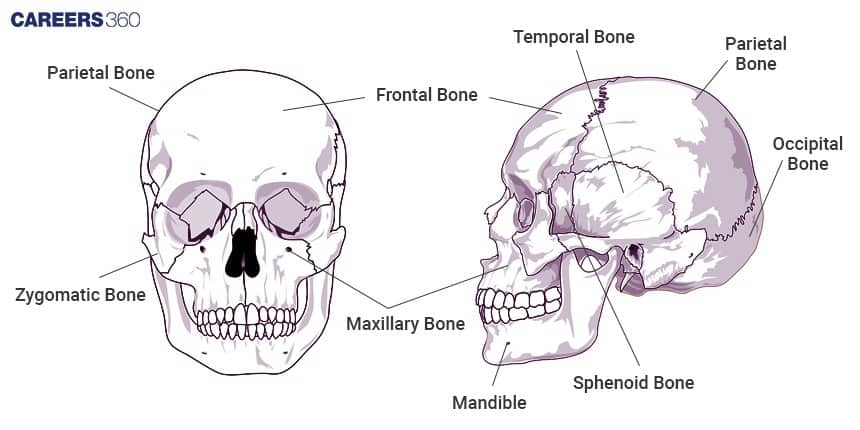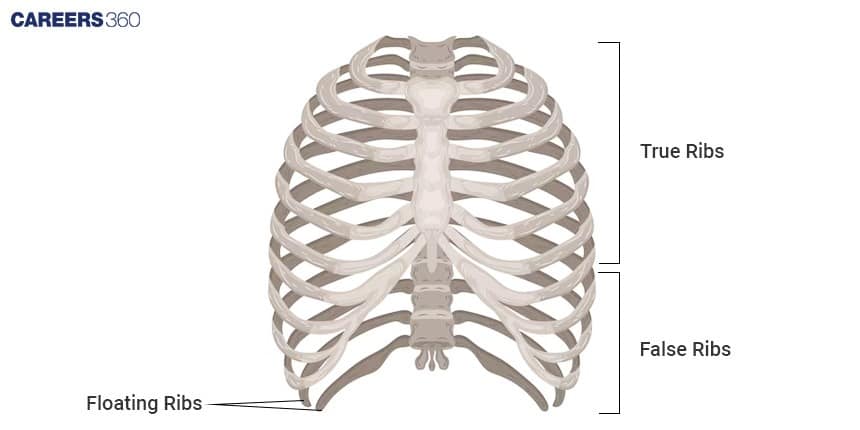Axial Skeleton System: Definition, Bones, Function, Description, Characteristics
The axial skeleton forms the central axis of the human body, consisting of 80 bones that include the skull, vertebral column, and thoracic cage. It protects vital organs such as the brain, spinal cord, heart, and lungs while maintaining posture and stability. This guide covers definition, components, bone classification, functions, diagrams, FAQs, and NEET-focused MCQs.
This Story also Contains
- What Is the Axial Skeleton?
- Components of the Axial Skeleton
- Functions Of The Axial Skeleton
- Axial Skeleton vs Appendicular Skeleton
- Axial Skeletal System NEET MCQs (With Answers & Explanations)

What Is the Axial Skeleton?
The axial skeleton is one of the essential constituents of the human skeletal system, comprising 80 bones that form the central axis of the body. This includes the skull, vertebral column, and rib cage. These structures are protective for the brain, spinal cord, and thoracic organs such as the heart and lungs.
It maintains the posture of the body, supports the head, and provides anchorage to the muscles, which aid in locomotion. Its rigid structure protects vital organs of the body from physical injury. Moreover, it forms the base to which the appendicular skeleton is attached and serves to provide stability and balance within the human anatomy.
Components of the Axial Skeleton
The components are explained below-
Skull
The skull is a complicated structure comprising 22 bones which protect the brain and form the framework of the face.
Cranial bones
There are 8 cranial bones - coronal, parietal, temporal, occipital, sphenoid, ethmoid---which act as a protective covering for the brain.
Facial bones
Facial bones--there are a total of 14. These include the mandible, maxilla, nasal, and zygomatic bones. Such bones form the face and anchor the facial muscles.

Vertebral Column
The vertebral column or spine is a flexible, segmented structure comprising 33 vertebrae that support the body while protecting the spinal cord.
Region | Number | Major function |
Cervical | 7 | Supports the head and allows neck movements |
Thoracic | 12 | Attached to the ribs anchoring the thoracic cage |
Lumbar | 5 | Supports the weight of the body, gives flexibility and movement |
Sacral | 5 fused | Form the back part of the pelvis |
Coccygeal | 4 fused | Also known as the tailbone, it supports one while sitting |

Thoracic Cage
A thoracic cage is a bony structure made of ribs and a sternum. It serves to protect the heart and lungs, providing support for breathing.
Ribs
These are curved bones extending from thoracic vertebrae toward the front portion of the body.
They protect against injury to thoracic organs.
Sternum
It is a flat bone in the middle of the chest.
Ribs are attached to it with the help of costal cartilage.

Functions Of The Axial Skeleton
The functions are explained below-
Protection
The axial skeleton serves to protect the vital organs. It encases and protects the brain within the skull, shelters the spinal cord within the vertebral column, and has the thoracic cage protecting the heart and lungs from physical damage
Support
The axial skeleton offers structure and framework support for the overall structure of the body. It supports posture and stability which allows the upright standing and weight endurance of the human body.
Movement
The axial skeleton acts as a framework over which many muscles get attached. Then, the attachment of muscles to these bones provides motion in the form of bending, twisting, or balancing.
Hematopoiesis
The bones, mainly in the axial skeleton, contain red bone marrow. These include the vertebrae, sternum, and ribs. It is the site of hematopoiesis—the production of blood cells, including red blood cells, white blood cells, and platelets.
Axial Skeleton vs Appendicular Skeleton
The difference between axial skeleton and appendicular skeleton is discussed in the table below:
Features | Axial Skeleton | Appendicular Skeleton |
Main components | Skull, vertebral column, ribs, sternum | Limbs and girdles |
Number of bones | 80 bones | 126 bones |
Function | Supports and protects vital organs | Enables movement and locomotion |
Type of movements | Limited movement | Wide range of movements |
Location | Forms central axis of the body | Attached to axial skeleton |
Axial Skeletal System NEET MCQs (With Answers & Explanations)
Important questions asked in NEET from this topic are:
Components of axial skeletal system
Functions of axial skeletal system
Practice Questions for NEET
Q1. Among the following options given below, identify the specific bone situated within the skull.
Atlas
Coracoid and frontal
Pterygoid and frontal
Arytenoid and parietal
Correct answer: 3) Pterygoid and frontal
Explanation:
Option 3 states that the pterygoid and frontal bones are situated within the skull. Within the human skull, the pterygoid bone is a small, wing-shaped bone located in the cranial base. It is involved in forming part of the lateral walls of the nasal cavity and the floor of the eye sockets (orbit). The frontal bone, on the other hand, forms the forehead and the upper portion of the eye sockets.
Hence, the correct answer is option 3) Pterygoid and frontal.
Q2. Which is the key stone of Cranium
Sphenoid
Frontal
Occipital
Ethmoid
Correct answer: 1) Sphenoid
Explanation:
The sphenoid bone is considered the keystone of the skull because it articulates with all other cranial bones, providing structural stability. Located at the base of the cranium, it plays a crucial role in forming the skull’s framework and housing vital structures such as the pituitary gland. Its unique butterfly shape and central position allow it to connect and support the frontal, parietal, temporal, and occipital bones, making it an essential component of cranial anatomy.
Hence the correct answer is option 1) Sphenoid.
Q3. Parietal bones of the skull represent
Cartilaginous bones
Investing bones
Sesamoid bones
Visceral bones
Correct answer: 4) Investing bones
Explanation:
In intramembranous ossification, development occurs within the frontal, nasal, and parietal bones of the skull. Here, the dermis of the skin has mesenchymal cells that differentiate directly into osteoblasts, hence building bone without a template of cartilage. These osteoblasts get entrapped by their secretion of osteoid and eventually differentiate into osteocytes, making flat bones and forming part of the protective structure of the skull.
Hence, the correct answer is option 2) Investing in bones.
Also Read:
Frequently Asked Questions (FAQs)
The axial skeleton consists of three parts: the skull, the vertebral column, and the thoracic cage.
The vertebral column acts as a pivot for anchorage for muscles because it is flexible—in a way it bends, twists, and undergoes other motions—provided the bony column allows movements without a disturbance in the balance or a change in the posture of the body.
The axial skeleton does the following: protects the brain, spinal cord, heart and lungs; provides structural support, maintains posture, serves as a framework for muscle attachment and movement, houses red bone marrow needed for blood cell production, hematopoiesis.
There are 80 bones: 22 in the skull, 26 in the vertebral column, and 24 ribs plus the sternum in the thoracic cage.
Osteoporosis can cause a loss in the density of the bones. Herniated discs displace spinal discs out of position, while scoliosis curves the abnormality of the spine. Fractures are breaks in bones, while arthritis involves inflammation of joints.